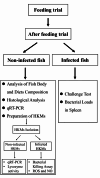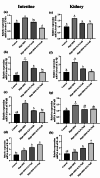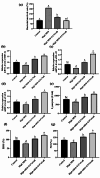The role of sodium butyrate in modulating growth, intestinal health, and antimicrobial efficacy in turbot (Scophthalmus maximus L.) fed high soy diets
- PMID: 39739006
- PMCID: PMC11685986
- DOI: 10.1038/s41598-024-83704-w
The role of sodium butyrate in modulating growth, intestinal health, and antimicrobial efficacy in turbot (Scophthalmus maximus L.) fed high soy diets
Abstract
Butyrate is one of the most abundant short-chain fatty acids (SCFAs), which are important metabolites of dietary fiber by fermentation of gut commensals, and has been shown to be vital in maintaining host health. The present study mainly investigated how sodium butyrate (NaB) supplementation in the diet with high proportion of soybean meal (SBM) affected turbot. Four experimental diets were formulated: (1) fish meal (FM) based diet (control group), (2) SBM protein replacing 45% FM protein in the diet (high SBM group), (3) 0.2% NaB supplementation in the high SBM diet (high SBM + 0.2% NaB group), and (4) 0.5% NaB supplementation in the high SBM diet (high SBM + 0.5% NaB group). The fish were fed four different diets for 8 weeks. The results showed that the high SBM diet significantly suppressed growth performance, induced typical enteritis symptoms and decreased resistance to bacterial infection. However, inclusion of 0.2% and 0.5% NaB in the high SBM diet both effectively increased the growth performance of turbot. Meanwhile, dietary NaB protected the intestinal morphology, and regulated the gene expression of inflammatory cytokines to relieve the inflammation of turbot, such as TNFα, IL-1β, NFκB and IL-10. Moreover, supplementation with NaB in the high SBM diet activated HIF-1α/IL-22/Lysozyme signaling pathway to against Edwardsiella tarda (E. tarda) infection, especially 0.5% NaB supplementation exerted more effectively to defence bacterial infection under inflammatory state. In conclusion, dietary NaB significantly promoted growth and gut health of turbot. Besides, it enhanced the resistance of fish to bacterial infection, especially dietary 0.5% NaB supplementation.
Keywords: Scophthalmus maximus L.; Growth; Inflammatory cytokines; Signaling pathways; Sodium butyrate (NaB); Soybean.
© 2024. The Author(s).
Conflict of interest statement
Declarations. Competing interests: The authors declare no competing interests. Ethical approval: The study was conducted in accordance with the protocols for animal care, handling procedures and animal anesthesia, and approved by the Laboratory Animal Care Committee in Weifang University of Science and Technology. ARRIVE statement: We followed the ARRIVE (Animal Research: Reporting of In Vivo Experiments) guidelines ( https://arriveguidelines.org ).
Figures






Similar articles
-
The Effects of Sodium Propionate Supplementation in the Diet with High Soybean Meal on Growth Performance, Intestinal Health, and Immune Resistance to Bacterial Infection in Turbot (Scophthalmus maximus L.).Aquac Nutr. 2022 Aug 31;2022:8952755. doi: 10.1155/2022/8952755. eCollection 2022. Aquac Nutr. 2022. PMID: 36860468 Free PMC article.
-
Sodium butyrate supplementation in high-soybean meal diets for turbot (Scophthalmus maximus L.): Effects on inflammatory status, mucosal barriers and microbiota in the intestine.Fish Shellfish Immunol. 2019 May;88:65-75. doi: 10.1016/j.fsi.2019.02.064. Epub 2019 Mar 3. Fish Shellfish Immunol. 2019. PMID: 30840856
-
Protective effect of glutamine and arginine against soybean meal-induced enteritis in the juvenile turbot (Scophthalmus maximus).Fish Shellfish Immunol. 2017 Nov;70:95-105. doi: 10.1016/j.fsi.2017.08.048. Epub 2017 Sep 4. Fish Shellfish Immunol. 2017. PMID: 28882796
-
Dietary methanotroph bacteria meal alleviates soybean meal-induced enteritis by improving immune tolerance and intestinal flora profile of juvenile turbot (Scophthalmus maximus L.).Fish Shellfish Immunol. 2024 May;148:109463. doi: 10.1016/j.fsi.2024.109463. Epub 2024 Feb 23. Fish Shellfish Immunol. 2024. PMID: 38402918
-
Dietary lipid levels affected antioxidative status, inflammation response, apoptosis and microbial community in the intestine of juvenile turbot (Scophthalmus maximus L.).Comp Biochem Physiol A Mol Integr Physiol. 2022 Feb;264:111118. doi: 10.1016/j.cbpa.2021.111118. Epub 2021 Nov 16. Comp Biochem Physiol A Mol Integr Physiol. 2022. PMID: 34793954 Review.
References
-
- Martin-Gallausiaux, C. & Marinelli, L. SCFA: Mechanisms and functional importance in the gut. Proc. Nutr. Soc.80, 37–49. 10.1017/s0029665120006916 (2021). - PubMed
-
- Abdel-Latif, H. M., Abdel-Tawwab, M., Dawood, M. A., Menanteau-Ledouble, S. & El-Matbouli, M. Benefits of dietary butyric acid, sodium butyrate, and their protected forms in aquafeeds: A review. Rev. Fish. Sci. Aquac.28, 421–448. 10.1080/23308249.2020.1758899 (2020).
-
- Aalamifar, H. et al. Dietary butyric acid improved growth, digestive enzyme activities and humoral immune parameters in Barramundi (Lates calcarifer). Aquac. Nutr.26, 156–164. 10.1111/anu.12977 (2020).
-
- Mirghaed, A. T., Yarahmadi, P., Soltani, M., Paknejad, H. & Hoseini, S. M. Dietary sodium butyrate (Butirex(®) C4) supplementation modulates intestinal transcriptomic responses and augments disease resistance of rainbow trout (Oncorhynchus mykiss). Fish Shellfish Immunol.92, 621–628. 10.1016/j.fsi.2019.06.046 (2019). - PubMed
-
- Zhang, J. et al. Sodium butyrate supplementation in high-soybean meal diets for juvenile rice field eel (Monopterus albus): Effects on growth, immune response and intestinal health. Aquaculture.520, 734952. 10.1016/j.aquaculture.2020.734952 (2020).
Publication types
MeSH terms
Substances
LinkOut - more resources
Full Text Sources

